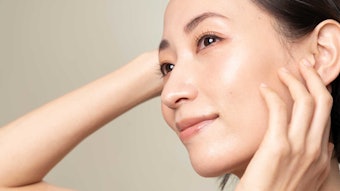
As previously reported, Kao Corp. developed its sprayable Fine Fiber Technology to form a thin membrane on skin that feels light, soft and natural, and promotes smooth, even makeup coverage.
Initial commercial launches based on the technology were rolled out in late 2020. More recently, the company showed the fine fiber membrane protects skin by keeping pollen, PM2.5, etc., from coming into direct contact with skin, and by reducing chafing caused by facial masks. In addition, it adsorbs sebum from the skin and together with the contaminants adhered to it, the membrane can be removed by simply peeling it away.
In its latest study, Kao examined the three-dimensional membrane formed by the fiber technology and found an average gap between fibers of 1.8 microns, as determined using a porosimeter. This size is relatively smaller than atmospheric pollutants (dirt), at PM2.5, so the researchers presumed the fiber could capture these contaminants.
See related: Anti-pollution Cosmetics; In the Face of a Changing Environment
To test this theory, the fine fiber membrane was formed on model skin and observed by electron microscope after atmospheric pollutants (dirt) such as pollen, dust, graphite and PM2.5 adhered to the membrane. Images confirmed the atmospheric pollutants were retained within the gaps or on top of the membrane. In addition, removing the membrane with the particles adhered to it resulted in the nearly complete removal of pollutants from the model skin.
Furthermore, the membrane was shown to protect skin and a formulation against physical wear and chafing due to mask-wearing. For this study, five men and women in their 20s to 30s wore face masks for approx. 4 hr after applying a long-wear formulation to the face; here, only one cheek also was treated with the fine fiber membrane. Results showed the fine fiber treatment retained the membrane and formulation after 4 hr, whereas most of the film from the formulation alone was worn away. This indicated the fine fiber membrane retained the formulation but also reduced abrasion and chafing by the mask.
'We believe this technology will lead to the development of new types of products that span multiple categories such as skin care and makeup.'
Finally, sebum absorption by the membrane was assessed based on previous findings revealing a high capillary force acting on the fine fiber due to its porous structure. Here, the fine fiber membrane was formed on one cheek of 29 women in their 20s to 50s, and sebum was collected from the skin of both cheeks after 4 hr and quantified by liquid chromatography-mass spectrometry (LC/MS). Results showed higher amounts of sebum on the untreated cheek. LC/MS also showed ~70% of the secreted sebum had transferred to the membrane.
Masayuki Uchiyama, a senior researcher in Kao's skin care lab, commented, "Although we had known that the membrane formed with our Fine Fiber Technology has a dense structure with a high capillary force, we had not been able to effectively convey its benefits to our customers. Once we reconsidered the possible roles of the membrane, we realized that it has a function to protect the skin itself."
Uchiyama added, "We believe that the fine fiber membrane can absorb sebum from the skin and protect the body from the external environment, while also retaining moisture in the skin. Even though there have been other polymeric coating products in the past, they mostly had thick membranes that resulted in a unnatural appearance, and none of them had the above skin functions. We believe this technology will lead to the development of new types of products that span multiple categories such as skin care and makeup."










